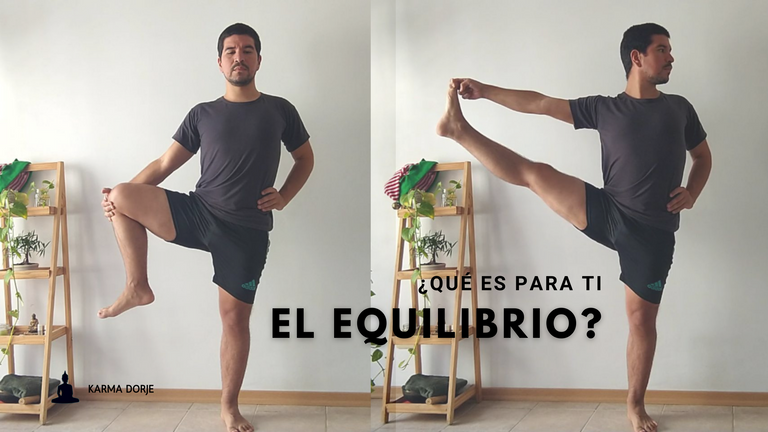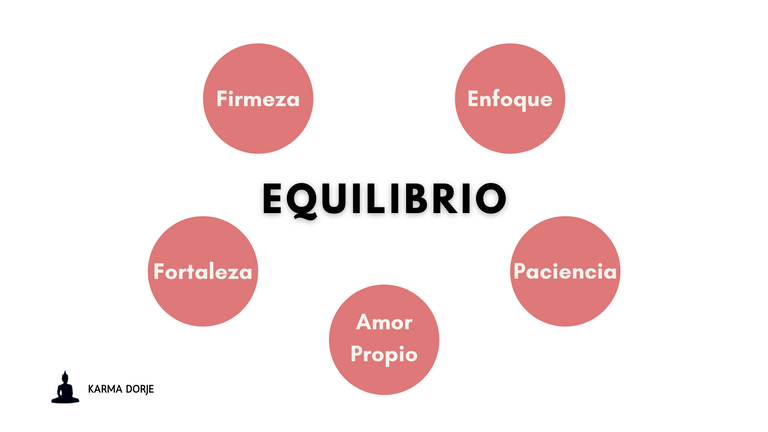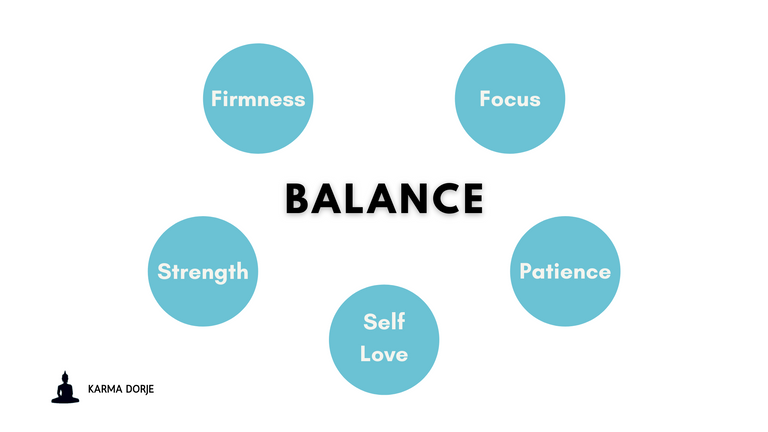¿Qué es el equilibrio para ti? - What is balance for you? [ES/EN]

ESPAÑOL
¡Hola gente linda de HIVE y de @ecotrain !
En medio de estos días caóticos, producto de las fiestas navideñas, he estado conversando mucho con las personas que continúan asistiendo a mis clases.
Si, caóticos porque acá en Argentina, esta fecha no solo coincide con las navidades sino que también con las vacaciones de Verano y además con el cierre del año escolar y laboral. Entonces, hay miles de eventos, fiestas, cierres fiscales, viajes a lugares de origen, vacaciones, etc.
Bajo esa primicia podrás imaginarte la locura que ronda en la cabeza de toda la gente estos días.
La pérdida del equilibrio, mental y físico se hace notar fácilmente en momentos como estos, entonces se me ha ocurrido ir preguntándole a algunos:
¿Qué es para ti el equilibrio?
Algunas respuestas que me dieron fueron:
- Es difícil, cuesta mucho
- Es fluir con el movimiento
- Es una búsqueda constante
- Mantenernos inmóviles
- Estar centrados
- Entre otras
Lo que yo pienso
Durante todos estos años, he notado que cada vez que alguien tiene que lidiar con las posturas de equilibrio, ésta se enfrenta directamente con la frustración que se manifiesta de no poder lograr sostenerse sin caer, y posteriormente con la ira que esto genera.
La incomodidad que surge de una situación que no podemos controlar, nos genera estas emociones muy fácilmente. Y parece fundamental, al menos para mi, practicarlas con constancia, para poder aprender de esas emociones y lograr trascenderlas.
Esto requiere mucha firmeza, paciencia, amor propio, fortaleza y una gran capacidad de enfoque, que nos permita centrar nuestra mente en la tarea sin dejarse arrastrar por la corriente de pensamientos, que en ese momento surge.

En principio, debemos establecer una base firme que permita edificar estable el resto del cuerpo, para no tambalearnos tanto.
Por lo general las posturas de equilibrio vienen luego de una secuencia de posturas de pie o después de haber realizado una repetición de la secuencia de saludos al sol, que permite interactuar mejor con nuestras bases en el cuerpo: pies, piernas y caderas.
Una vez hemos desarrollado una buena base, con gran firmeza por la activación de los músculos, entonces será más sencillo sostenernos sobre un pie sin tanto movimiento físico.
Este tipo de Asanas o posturas, son un espejo de cómo están los contenidos de nuestra mente. Generalmente, cuando hay demasiado pensamiento, nos caemos porque no podemos enfocarnos en una sola cosa, y al no poder tener un enfoque correcto, todo nuestro organismo no puede tener un sistema de referencia para poder mantener su centro en eje y con ello, perdemos equilibrio.
Esto, obviamente, varía mucho; unos días podemos más que otros, y eso se debe sencillamente a que nuestra mente está más descansada, enfocada y limpia unos días que otros.
Pero, ¿qué pasa cuando nos caemos?
Nada, no pasa realmente nada. Simplemente vuelves a levantarte. Cuando recordamos esto constantemente al momento de practicar, entendemos que no hay necesidad de frustrarnos ni sentir ira por caernos o por no poder controlar lo que hace nuestro cuerpo en ese preciso momento, y es con esa aceptación que surge el amor propio.
Adoptando una actitud más amorosa con nosotros mismos al momento de practicar, entonces se facilita mucho más la práctica (y el alcance de los objetivos), y el proceso de superación de los obstáculos es más llevadero. Es decir, que una cosa retroalimenta la otra.
Claro que para que ese proceso y esa retroalimentación surja correctamente, debemos darle tiempo. Y entendiendolo, podemos cultivar la paciencia y la tolerancia con nuestros propios defectos temporales, y si logramos hacerlos, veremos que tener paciencia tiene grandes frutos y ventajas en nuestra vida, incluso fuera del mat de yoga (alfombra).
Con el desarrollo del amor propio y la paciencia, no puede surgir otra cosa que la fortaleza para afrontar la situación o postura de equilibrio. Esa fortaleza, también viene dada por nuestra respiración consciente que nos alimenta de nueva energía y nos vitaliza, activando mucho más nuestros sentidos y logrando que podamos tener un cuerpo cada vez más sano, más despierto, y por supuesto, equilibrado.
Y, obviamente, todo esto se manifestará posteriormente, en nuestras mentes.
Respondiendo a mi propia pregunta: ¿Qué es para mi el equilibrio?
Finalmente, luego de decir todo esto, solo podría pensar que es un encuentro.
Si, un encuentro entre los extremos, que no es ni puede ser completamente estático, sino al contrario, deberá ser dinámico. En el que momento a momento (presente) debemos estar recalculando y notando lo que se va requiriendo para que ese encuentro continue siendo armonioso y así no terminar cayéndonos.
Y para tí: ¿Qué es el equilibrio?

ENGLISH
In the midst of these chaotic days, due to the Christmas holidays, I have been talking a lot with the people who continue to attend my classes.
Yes, chaotic because here in Argentina, this date not only coincides with Christmas but also with the summer vacations and also with the end of the school and work year. So, there are thousands of events, parties, fiscal closings, trips to places of origin, vacations, etc.
Under that scoop you can imagine the madness that goes around in the head of all the people these days.
The loss of balance, mental and physical, is easily noticed in moments like these, so I thought of asking some of them:
What is balance for you?
Some of the answers I got were:
- It is difficult, it costs a lot
- It is to flow with the movement
- It is a constant search
- To keep still
- To be centered
- Among others
What I think
During all these years, I have noticed that every time someone has to deal with balancing postures, they are directly confronted with the frustration that comes from not being able to hold on without falling, and subsequently with the anger that this generates.
The discomfort that arises from a situation that we cannot control, generates these emotions very easily. And it seems fundamental, at least for me, to practice them with constancy, to be able to learn from these emotions and to be able to transcend them.
This requires a lot of firmness, patience, self-love, fortitude and a great capacity of focus, which allows us to focus our mind on the task without being dragged by the stream of thoughts, which at that moment arises.

In principle, we must establish a firm base that allows us to build stable the rest of the body, so that we do not wobble so much.
Usually the balancing postures come after a sequence of standing postures or after having performed a repetition of the sun salutation sequence, which allows us to better interact with our bases in the body: feet, legs and hips.
Once we have developed a good base, with great firmness through the activation of the muscles, then it will be easier to stand on one foot without so much physical movement.
These types of Asanas or postures are a mirror of how the contents of our mind are. Generally, when there is too much thinking, we fall because we can not focus on one thing, and not being able to have a correct focus, our whole organism can not have a reference system to maintain its center in axis and thus, we lose balance.
This obviously varies a lot; some days we can do more than others, and that is simply because our mind is more rested, focused and clean some days than others.
But what happens when we fall?
Nothing, nothing really happens. You just get back up again. When we constantly remember this when we practice, we understand that there is no need to get frustrated or feel anger for falling or for not being able to control what our body is doing at that very moment, and it is with that acceptance that self-love arises.
Adopting a more loving attitude with ourselves at the moment of practice, then the practice (and the achievement of the objectives) is much easier, and the process of overcoming obstacles is more bearable. In other words, one thing feeds back into the other.
Of course, for this process and this feedback to emerge correctly, we must give it time. And understanding this, we can cultivate patience and tolerance with our own temporary defects, and if we manage to do them, we will see that having patience has great fruits and advantages in our life, even outside the yoga mat.
With the development of self-love and patience, nothing else can arise but the strength to face the situation or posture of balance. That strength is also given by our conscious breathing that feeds us with new energy and vitalizes us, activating our senses much more and achieving that we can have an increasingly healthy body, more awake, and of course, balanced.
And, obviously, all this will manifest later on, in our minds.
Answering my own question: What is balance for me?
Finally, after saying all this, I could only think that it is an encounter.
Yes, an encounter between extremes, which is not and cannot be completely static, but on the contrary, it must be dynamic. In which moment by moment (present) we must be recalculating and noticing what is required for this encounter to continue to be harmonious and thus not end up falling.
And for you: What is balance?

Soy Julio Cesar Arvelo, practicante y profesor de Ashtanga Yoga y Meditación.
- Si te gustó este post y quieres seguir leyéndome, bienvenido a seguirme.
- Todas las imagenes han sido creada por mi através de Canva.com
I am Julio Cesar Arvelo, practitioner and teacher of Ashtanga Yoga and Meditation.
- If you liked this post and want to keep reading me, welcome to follow me.
- All images have been created by me through Canva.com.
Mi redes sociales:

Yes o it really matters
What do you think about it?
It what should be done on a daily basis
I am agree with you!
Hola @karmadorje, este post ha sido votado por la cuenta @Cervantes, saludos!!! =]
Muchas gracias por su apoyo!! @fridakahlo y @cervantes